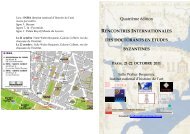booklet of abstracts - Oxford University Byzantine Society
booklet of abstracts - Oxford University Byzantine Society
booklet of abstracts - Oxford University Byzantine Society
Create successful ePaper yourself
Turn your PDF publications into a flip-book with our unique Google optimized e-Paper software.
Session four4:15 | Friday 4 March 2011ChairAnnika AspExeter College‘The Land <strong>of</strong> the Beautiful Horses’:The archaeology <strong>of</strong> medievalstables in CappadociaFiliz Tütüncü-Çağlar<strong>University</strong> <strong>of</strong> Victoria, CanadaRenowned since antiquity as the legendary‘Land <strong>of</strong> the Beautiful Horses,’ Cappadociahas been an important horse-breeding centrethroughout its history. The present work isa study on horses and horse breeding in thisregion in the tenth and eleventh centuries, withspecial attention being paid to the architecturalevidence, namely, the rock‐cut stables. The timeperiod under question is marked by changeand revival in <strong>Byzantine</strong> history, in whichCappadocia played a vital role for the defenseand expansion <strong>of</strong> Byzantium in the east.The point <strong>of</strong> departure for the presentwork is a hypothesis suggested by V.G. Kalasthat the landowner families living in monumentalrock-cut mansions <strong>of</strong> Cappadociaduring the middle <strong>Byzantine</strong> period bredhorses in their large stables to supply their owntroops, as well as those <strong>of</strong> the imperial army.In order to evaluate this theory further andshed light on the history <strong>of</strong> horse breeding in<strong>Byzantine</strong> Cappadocia, this paper investigatesthe stables <strong>of</strong> the elite residences within theirbroader archaeological, ethno-archaeologicaland historical context.Although there is no question about thepresence <strong>of</strong> other types <strong>of</strong> domestic livestock,as also represented in architectural evidence,the present study proposes that the stables <strong>of</strong>the elite mainly functioned to house horsesand, perhaps, mules, probably bred for militarypurposes. Analysing the architecture <strong>of</strong>the stables in the light <strong>of</strong> literary evidence,this paper aims to draw attention to the value<strong>of</strong> horse breeding for the study <strong>of</strong> social andeconomic history <strong>of</strong> <strong>Byzantine</strong> Cappadocia.Filiz Tütüncü-Çağlar is a third-yearPhD candidate at the <strong>University</strong> <strong>of</strong> Victoria inCanada specialising in Islamic ceramics. Herresearch interests include cross-cultural interactionson the <strong>Byzantine</strong> and Islamic frontier, artand archaeology <strong>of</strong> Medieval Anatolia andNorth Syria, and underwater archaeology.Mantzikert reversed? The lastcampaign <strong>of</strong> Alexios I Komnenosin the Alexiad <strong>of</strong> Anna KomneneRoman ShlyakhtinCentral European <strong>University</strong>, BudapestThe battle <strong>of</strong> Mantzikert (1071) is a referencepoint for all historiographers <strong>of</strong> the Komnenianera. Anna Komnene is not an exception.She starts her work with a short mentioning<strong>of</strong> the military disaster. Anna places anothermentioning <strong>of</strong> Mantzikert at the very end <strong>of</strong>the Alexiad. According to her, in 1116 AlexiosI Komnenos (1081-1118) won a battle againstthe sultan <strong>of</strong> Ikonion, Shahanshah (1107-1116), near the city <strong>of</strong> Philomelion. After thedescription <strong>of</strong> the peace ceremony Anna narratesa story about this sultan. He became anally <strong>of</strong> Alexios Komnenos after the battle, butlater was betrayed and blinded during internecinewar the by one <strong>of</strong> his amirs.Shahanshah’s fate reminds me <strong>of</strong><strong>Byzantine</strong> emperor Romanos IV Diogenes,who was also defeated, captured andblinded. In the battle <strong>of</strong> Mantzikert, the<strong>Byzantine</strong>s were defeated by the Seljuks; in14 | Between Constantines





